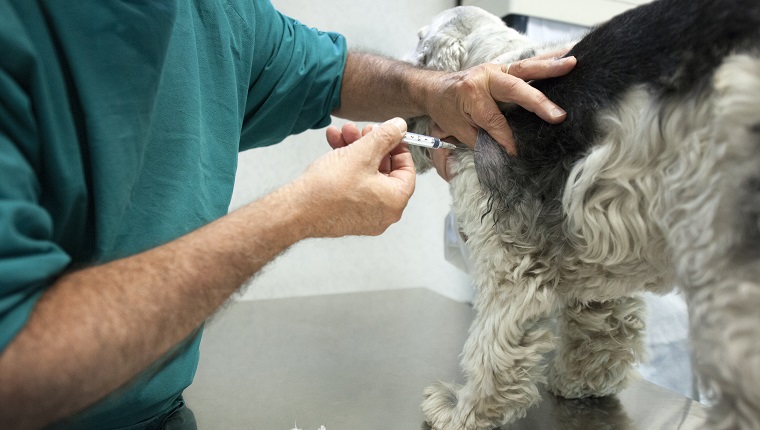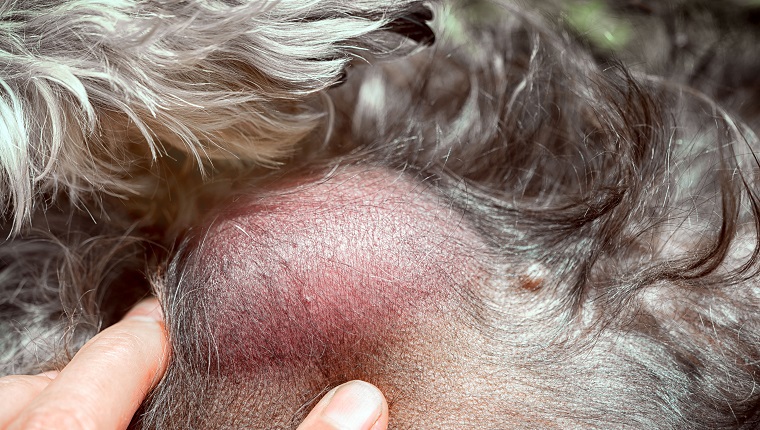Lipomas are mostly benign, fatty skin tumors that appear on dogs and are fairly common, especially as dogs age. They are usually a cosmetic issue unless they appear in vital areas such as the throat, thigh, or armpits.
Lipomas are also called fatty lumps or fatty tumors. While they generally aren’t dangerous, you must see your veterinarian if you notice unusual growths on your dog. Your vet can make sure that any growths are benign and won’t harm your dog.
Here’s what you should know about the symptoms, causes, and treatments of lipomas in dogs.
Symptoms Of Lipomas In Dogs

Lipomas are composed of fat surrounded by a membrane. They can be found almost anywhere on your dog’s body.
The lumps are moveable if you press them gently, non-painful, and will generally produce no changes in the skin above them. Some may be firmer to the touch.
Dogs may develop one fatty tumor or multiple lumps. These benign tumors are generally not dangerous, but some may grow large enough to cause your dog discomfort or interfere with your dog’s movement.
You should always see your vet if you notice growths on your dog, just to be safe. They can tell you for sure if your dog’s growths are harmless or a cause for concern.
Causes Of Lipomas In Dogs
Vets don’t fully know what causes lipomas to grow in dogs. However, some dogs have a higher likelihood of fatty tumors growing on their bodies.
Benign lumps are quite commonly found in middle aged and older dogs.
It appears that overweight dogs are more prone to developing these lumps. In fact, weight loss can sometimes reduce the size of lumps or cause them to disappear entirely. Of course, you should ask your vet before attempting any weight loss regimen with your dog.
Certain breeds, such as Weimaraners, also have a predisposition to fatty tumors.
Veterinary Treatments

Although a veterinarian may have a lot of experience seeing lumps and bumps, only a biopsy of the lump tissue can provide a definitive diagnosis. If your vet made a diagnosis on the basis of your dog’s physical exam only, then the diagnosis is actually only an educated guess.
Some vets prefer to perform a fine needle aspirate of the lump in which they insert a tiny needle into the lump to take a sample for evaluation. Vets can perform a relatively painless aspirate without anesthesia.
The problem with fine needle aspirate results is that they can give false readings that do not reflect a true representation of the lump’s characteristics. The only way to make a definitive diagnosis of the lump is to perform a biopsy and evaluate.
Most lipomas do not need to be removed from dogs, as they’re simply cosmetic lumps on the skin. When they appear in certain areas, however, they can cause problems.
Fatty tumors around the thighs or armpits can restrict movement, and vets may need to remove them. If the biopsy shows that a mass is an aggressive tumor, it may also need to be removed.
In some rare cases, an infiltrative lipoma will invade muscle tissue, making surgery difficult. Sometimes vets treat these with radiation therapy.
In general, removal is unnecessary. Fatty tumors tend to be slow-growing and local, meaning they don’t spread. They do often return after removal, so you may want to consider that if you’re planning to have them surgically removed for cosmetic reasons.
Otherwise, they tend to be nothing to worry about, and your dog will go on living a happy, normal life. Chances are good that the lumps won’t bother them, so they shouldn’t bother you.
Has your dog ever had a fatty tumor? Did your vet remove it, or just let it be? Let us know in the comments below!








